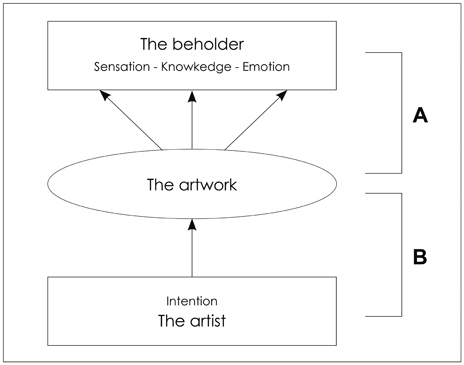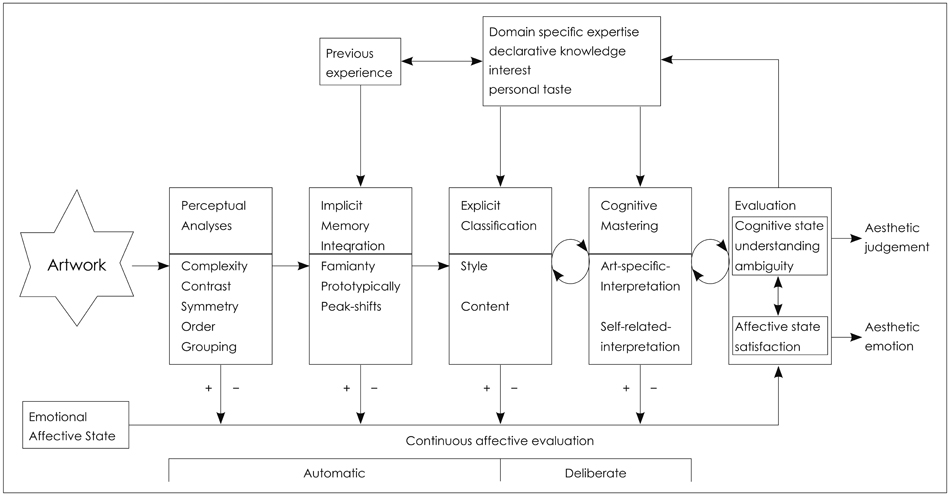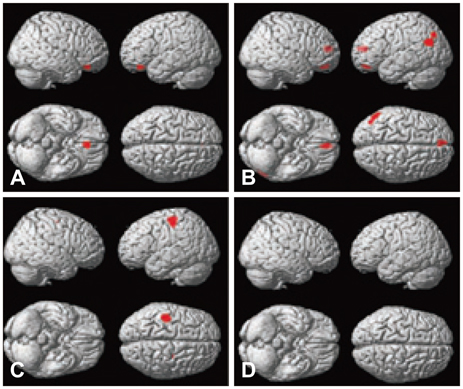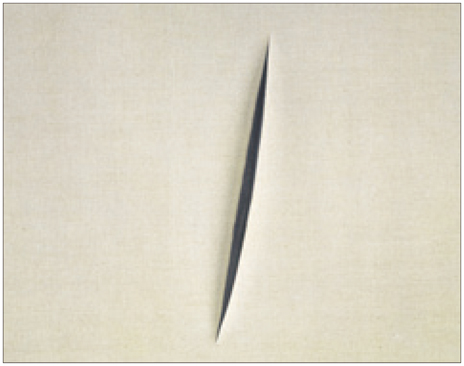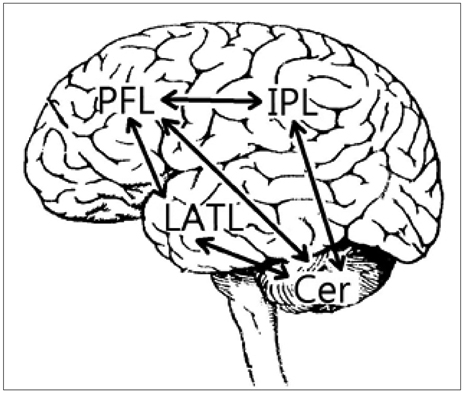J Korean Neuropsychiatr Assoc.
2013 Jan;52(1):3-16. 10.4306/jknpa.2013.52.1.3.
What is Neuroaesthetics? : A New Paradigm in Psychiatry
- Affiliations
-
- 1Department of Neuropsychiatry, College of Medicine, Chungbuk National University, Cheongju, Korea. mammosss@hanmail.net
- 2Department of Psychology, Chungbuk National University, Cheongju, Korea.
- 3Department of Visual Communication Design, Hansung University, Seoul, Korea.
- 4Department of Psychiatry, School of Medicine, Eulji University, Daejeon, Korea.
- KMID: 2194182
- DOI: http://doi.org/10.4306/jknpa.2013.52.1.3
Abstract
- Neuroaesthetics is an area of research on the essence of aesthetic experience according to the neurobiological perspective. The purpose of this article is to introduce both the important results from some studies based on neuroaesthetics and some neuroaesthetic reports in specific psychiatric disease. Aesthetic experience is thought to be a series of cognitive and affective processes for pursuing aesthetic judgment and aesthetic emotion. According to the present neuroaesthetic studies, the important domains are reward system, embodiment, aesthetic perspective in contrast with practical perspective, sublime, and so on. The neuroaesthetic approach to specific psychiatric disease is just beginning; however, case studies on the sudden appearance of artistic talents in neuropsychiatric patients have been frequently reported. We expect that neuroaesthetics is likely to continue to contribute new knowledge regarding the ultimate causes of various psychiatric diseases and the creativity of many psychiatric patients.
Keyword
Figure
Reference
-
1. Berlyne DE. Aesthetics and Psychobiology. 1971. New York: Appleton-Century-Crofts.2. Rentschler I, Herzberger B, Epstein D. Beauty and the Brain: Biological Aspects of Aesthetics. 1988. Berlin: Birkhäuser Verlag.3. Miller ZA, Miller BL. Shimamura AP, Palmer SE, editors. A Cognitive and Behavioral Neurological Approach to Aesthetics. Aesthetic Science: Conneting Minds, Brains, and Experience. 2012. New York: Oxford University Press;356–357.
Article4. Zeki S. Art and the brain. J Consciousness Stud. 1999. 6:76–96.
Article5. Nami MT, Ashayeri H. Where neuroscience art embrace; the neuroaesthetics. Basic Clin Neurosci. 2011. 2:6–11.6. Zeki S. Statement on Neuroesthetics. Available from http://www.neuroesthetics.org/statement-on-neuroesthetics.php.
Article7. Livingstone M. Vision and Art: The Biology of Seeing. 2002. New York: Abrams.8. Jee SH. Brain is beautiful. 2005. Paju: Haenamu.9. Kim CY, Blake R. Brain activity accompanying perception of implied motion in abstract paintings. Spat Vis. 2007. 20:545–560.
Article10. Lee SB, Jung WH, Son JW, Jo SW. Neural correlates of the aesthetic experience using the fractal images: an fMRI study. Korean J Sci Emot Sensibility. 2011. 14:403–414.11. Park SM. Neuroimaging Study for the effect of information about paintings on aesthetic preference for contemporary paintings [dissertation]. 2007. Daejeon: KAIST.12. Salimpoor VN, Benovoy M, Larcher K, Dagher A, Zatorre RJ. Anatomically distinct dopamine release during anticipation and experience of peak emotion to music. Nat Neurosci. 2011. 14:257–262.
Article13. Meister IG, Krings T, Foltys H, Boroojerdi B, Müller M, Töpper R, et al. Playing piano in the mind--an fMRI study on music imagery and performance in pianists. Brain Res Cogn Brain Res. 2004. 19:219–228.
Article14. Cross ES, Ticini LT. Neuroaesthetics and beyond: new horizons in applying the science of the brain to the art of dance. Phenom Cogn Sci. 2012. 11:5–16.
Article15. Calvo-Merino B, Jola C, Glaser DE, Haggard P. Towards a sensorimotor aesthetics of performing art. Conscious Cogn. 2008. 17:911–922.
Article16. Shimamura AP. Shimamura AP, Palmer SE, editors. Towards a Science of Aesthetics: Issues and Ideas. Aesthetic Science: Connecting Minds, Brains, and Experience. 2012. New York: Oxford University Press;23–24.17. Leder H, Belke B, Oeberst A, Augustin D. A model of aesthetic appreciation and aesthetic judgments. Br J Psychol. 2004. 95(Pt 4):489–508.
Article18. Ramachandran VS, Rogers-Ramachandran D. The neurology of aesthetics. Sci Am. 2008. 18:74–77.
Article19. Cupchik GC. Cupchik GC, Laszlo M, editors. From Perception to Production: A Multilevel Analysis of the Aesthetic Process. Emerging Visions of the aesthetic Process: Psychology, Semiology, and Philosophy. 1992. New York: Cambridge University Press;61–81.20. Csikszentmihalyi M. Sternberg RJ, editor. Implications of a Systems Perspective for the Study of Creativity. Handbook of Creativity. 1999. Cambridge: Caambridge University Press;313–335.
Article21. Cinzia DD, Vittorio G. Neuroaesthetics: a review. Curr Opin Neurobiol. 2009. 19:682–687.
Article22. Kawabata H, Zeki S. Neural correlates of beauty. J Neurophysiol. 2004. 91:1699–1705.
Article23. Kringelbach ML. The human orbitofrontal cortex: linking reward to hedonic experience. Nat Rev Neurosci. 2005. 6:691–702.
Article24. Vartanian O, Goel V. Neuroanatomical correlates of aesthetic preference for paintings. Neuroreport. 2004. 15:893–897.
Article25. Lee JM. A reformulation of the conceptual foundations of psychology (II): extending the concept of 'mind' and the extent of psychology, based on the perspectives of cognitive science. Korean J Psychol Gen. 2007. 26:1–38.26. Freedberg D, Gallese V. Motion, emotion and empathy in esthetic experience. Trends Cogn Sci. 2007. 11:197–203.
Article27. Di Dio C, Macaluso E, Rizzolatti G. The golden beauty: brain response to classical and renaissance sculptures. PLoS One. 2007. 2:e1201.
Article28. Born RT, Bradley DC. Structure and function of visual area MT. Annu Rev Neurosci. 2005. 28:157–189.
Article29. Kant I. Critique of Judgement. 1790. London: MacMillan.30. Cupchik GC, Vartanian O, Crawley A, Mikulis DJ. Viewing artworks: contributions of cognitive control and perceptual facilitation to aesthetic experience. Brain Cogn. 2009. 70:84–91.
Article31. Jacobsen T, Schubotz RI, Höfel L, Cramon DY. Brain correlates of aesthetic judgment of beauty. Neuroimage. 2006. 29:276–285.
Article32. Berlyne DE, Ogilvie JC. Berlyne ED, editor. Dimensions of perception of paintings. Studies in the New Experimental Aesthetics: Steps Toward an Objective Psychology of Aesthetic Appreciation. 1974. Washington: Hemisphere Pub;181–226.33. Vartanian O, Goel V. Emotional pathways in the brain mediate aesthetic preference. Bull Psychol Art. 2004. 5:37–42.34. Kim J, Shin EH, Kang H, Kim CY. Sad but Beautiful; Brain Responses to Emotional Appraisal and Aesthetic Judgement of Art. Poster Session Presented at the 17th Annual Meeting of the Organization on Human Brain Mapping. 2011. 2011 June; Qébec, Canada.35. Blood AJ, Zatorre RJ, Bermudez P, Evans AC. Emotional responses to pleasant and unpleasant music correlate with activity in paralimbic brain regions. Nat Neurosci. 1999. 2:382–387.
Article36. Kim DB. An analysis of the formlessness of contemporary graphic design regarding Lyotard's of the sublime. 2009. Seoul: Hongik Univ;[dissertation].37. Gablik S. Magritte. 1985. New York: Thames & Hudson Inc.38. Kirk U. The neural basis of object-context relationships on aesthetic judgment. PLoS One. 2008. 3:e3754.
Article39. Lee EA, Kim MM, Lee SB, Son JW. Unfamiliar in nature: Neural correlates of the aesthetic in perceptual novelty. 2011. In : 2011 Spring Meeting of Korean Society for Human Brain Mapping; 2011 November 4; Seoul: Korean Society for Human Brain Mapping.40. Kapur N. Paradoxical functional facilitation in brain-behaviour research. A critical review. Brain. 1996. 119(Pt 5):1775–1790.
Article41. Frith U. Autism: Explaining the Enigma. 1989. Blackwell: Oxford.42. Happé F. Autism: cognitive deficit or cognitive style? Trends Cogn Sci. 1999. 3:216–222.
Article43. Boso M, Emanuele E, Prestori F, Politi P, Barale F, D'Angelo E. Autism and genius: is there a link? The involvement of central brain loops and hypotheses for functional testing. Funct Neurol. 2010. 25:15–20.44. Durand CM, Betancur C, Boeckers TM, Bockmann J, Chaste P, Fauchereau F, et al. Mutations in the gene encoding the synaptic scaffolding protein SHANK3 are associated with autism spectrum disorders. Nat Genet. 2007. 39:25–27.
Article45. Schoorlemmer J, Goldfarb M. Fibroblast growth factor homologous factors are intracellular signaling proteins. Curr Biol. 2001. 11:793–797.
Article46. Futai K, Kim MJ, Hashikawa T, Scheiffele P, Sheng M, Hayashi Y. Retrograde modulation of presynaptic release probability through signaling mediated by PSD-95-neuroligin. Nat Neurosci. 2007. 10:186–195.
Article47. Casanova MF, Buxhoeveden DP, Brown C. Clinical and macroscopic correlates of minicolumnar pathology in autism. J Child Neurol. 2002. 17:692–695.
Article48. Snyder A. Explaining and inducing savant skills: privileged access to lower level, less-processed information. Philos Trans R Soc Lond B Biol Sci. 2009. 364:1399–1405.
Article49. Wallace GL, Happé F, Giedd JN. A case study of a multiply talented savant with an autism spectrum disorder: neuropsychological functioning and brain morphometry. Philos Trans R Soc Lond B Biol Sci. 2009. 364:1425–1432.
Article50. Miller BL, Cummings J, Mishkin F, Boone K, Prince F, Ponton M, et al. Emergence of artistic talent in frontotemporal dementia. Neurology. 1998. 51:978–982.
Article51. Liu A, Werner K, Roy S, Trojanowski JQ, Morgan-Kane U, Miller BL, et al. A case study of an emerging visual artist with frontotemporal lobar degeneration and amyotrophic lateral sclerosis. Neurocase. 2009. 15:235–247.
Article52. Miller BL, Boone K, Cummings JL, Read SL, Mishkin F. Functional correlates of musical and visual ability in frontotemporal dementia. Br J Psychiatry. 2000. 176:458–463.
Article53. Espinel CH. de Kooning's late colours and forms: dementia, creativity, and the healing power of art. Lancet. 1996. 347:1096–1098.
Article54. Finney GR, Heilman KM. Artwork before and after onset of progressive nonfluent aphasia. Cogn Behav Neurol. 2007. 20:7–10.
Article55. Seeley WW, Matthews BR, Crawford RK, Gorno-Tempini ML, Foti D, Mackenzie IR, et al. Unravelling Boléro: progressive aphasia, transmodal creativity and the right posterior neocortex. Brain. 2008. 131(Pt 1):39–49.
Article56. Amaducci L, Grassi E, Boller F. Maurice Ravel and right-hemisphere musical creativity: influence of disease on his last musical works? Eur J Neurol. 2002. 9:75–82.
Article57. Billig O. Is schizophrenic expression art? A comparative study of creativeness and schizophrenic thinking. J Nerv Ment Dis. 1971. 153:149–164.58. Russell-Lacy S, Robinson V, Benson J, Cranage J. An experimental study of pictures produced by acute schizophrenic subjects. Br J Psychiatry. 1979. 134:195–200.
Article59. Chen Y, Norton D, McBain R. Can persons with schizophrenia appreciate visual art? Schizophr Res. 2008. 105:245–251.
Article60. Crow TJ. Is schizophrenia the price that Homo sapients pays fory language? Schizophr Res. 1997. 28:127–141.61. Mithen S. The Singing Neanderthals: The Origins of Music, Language, Mind and Body. 2005. Cambridge: Harvard University Press.62. Mottron L, Peretz I, Belleville S, Rouleau N. Absolute pitch in autism: a case study. Neurocase. 1999. 5:485–501.
Article63. Foxe JJ, Doniger GM, Javitt DC. Early visual processing deficits in schizophrenia: impaired P1 generation revealed by high-density electrical mapping. Neuroreport. 2001. 12:3815–3820.
Article64. Behrmann M, Thomas C, Humphreys K. Seeing it differently: visual processing in autism. Trends Cogn Sci. 2006. 10:258–264.
Article65. Schlotterer G, Moscovitch M, Crapper-McLachlan D. Visual processing deficits as assessed by spatial frequency contrast sensitivity and backward masking in normal ageing and Alzheimer's disease. Brain. 1984. 107(Pt 1):309–325.
Article66. Shen YJ. Short-term group play therapy with Chinese earthquake victims: effects on anxiety, depression, and adjustment. Int J Play Ther. 2002. 11:43–63.
Article67. Stewart EG. Art therapy and neuroscience blend: working with patients who have dementia. Art Ther J Am Art Ther Ass. 2004. 21:148–155.
Article68. Lusebrink VJ, Alto P. Art therapy and the brain: an attempt to understand the underlying processes of art expression in therapy. Art Ther J Am Art Ther Ass. 2004. 21:125–135.
Article69. Lee E, Kim M, Lee H, Lee S, Son JW. The "perceptual novelty" and the education effect; a neuroaesthetic study. Poster session presented at the Asia-Pacific Conference on Vision. 2012. 2012 July; Incheon, Korea.70. Lee JS. Communication by the senses. Social Psychology Bulletin. 2011. 06.
- Full Text Links
- Actions
-
Cited
- CITED
-
- Close
- Share
- Similar articles
-
- Major Depressive Disorder: Current Advances and Paradigm Shifts
- Symptom Remission Related to Increased Drug Response after Conversion Into Schizophrenia in Early Psychosis : A Case Report
- Old Age Psychiatry: Overview
- The Contingent Negative Variation in Remitted Paediatric Bipolar Patients: No Evidence of Abnormality
- Looking for a New Paradigm on the Treatment of Depression

